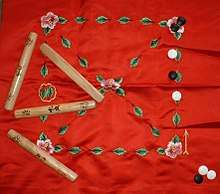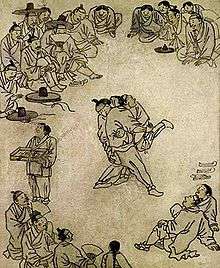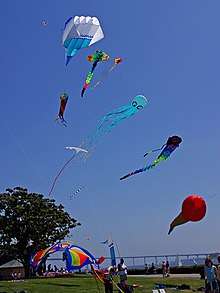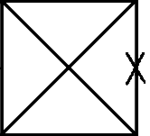Traditional games of Korea
Traditional games of Korea (Hangul: 전통놀이; Hanja: 傳統--; Jeontongnori) have been influenced by the culture, history and environment of the Korean Peninsula. Koreans have enjoyed games throughout history with family and friends, and the games create a sense of community. The most popular traditional games are Ganggang Sulrae, Jegichagi, Neolttwigi, Ssireum, Tuho, Hitting tombstone and Yutnori.
Characteristics
Korea's traditional games originated from folk beliefs. The peninsula has been agrarian since ancient times, and Koreans have believed in gods who protect nature and their lands. Exorcisms were performed to increase crops and animal well-being, with singing and dancing popular activities. Traditional games developed during this early period. Although many folk beliefs have disappeared, the games continue to be played.
The names and rules of the games differ by region. In Gyeonggi-do Gonu is called "Gonu, Goni, Ggoni", but in Jeonlado it is called "Ggon, Ggonu". Under Japanese rule, nearly all traditional games in Korea disappeared.
Most games (such as Tuho, Ssireum and kite flying) are played with the hands, using movement, and do not require equipment or a play area. The games are related to the four seasons.

Games
Yutnori
Yutnori, a board dice game with four wooden sticks, is one of the most popular traditional games of Korea and is usually played on the first day of the New Year by two players (or teams). Each player (or team of two players) takes turns throwing yut sticks. Each stick has two sides (round and flat), which makes the stick roll. Five combinations are possible with yut sticks: do, gae, geol, yut and mo. A player achieving a yut or mo is allowed to roll again. If a board piece lands on a space occupied by an opponent, it is returned to the start and the player goes again. If a piece lands on a space occupied by one's own team, the pieces can go together (counting as one). The combinations determine how the board pieces are moved, and the team which moves all four pieces around the board first wins. The game has its roots in divination rituals.[1]

Ssireum (wrestling)
Ssireum is similar to Japanese sumo wrestling, with two opponents wrestling each other in a sandy ring. The player who throws his opponent to the ground scores a point. Annual competitions are held, which are popular. Ssireum, a contest of strength and technique, is a form of wrestling unique to Korea.[2]
Traditionally practiced as combat and self-defense, ssireum was also part of rituals conducted in the ancient tribal states. Rules evolved, allowing ssireum to develop into a national sport valued for competition and entertainment.
Top-spinning

In top-spinning, played primarily by children, a player spins a wooden top with a stick to make it spin on ice or on the ground. Popular in winter, the games have names which vary by region. The best tops (made from birch, jujube or pine) are heavy, with strong tips, and they are often spun in groups.[3]
Kite flying

Kite frames are generally made of bamboo, with paper attached. Most kites, rectangular or stingray-shaped, are tethered with string on a reel. Kite flying is a traditional winter game for children and adults. There is a period of kite flying from New Year's Day to Daeboreum, after which the kite string is cut for it to fly away. Kite flying is less common, due to work obligations, but kites were flown as a distraction from winter cold.[4]
Tuho

Tuho was originally popular among royal families and the upper class. In a manner similar to horseshoes, tuho players attempt to throw arrows into the top of a narrow-necked wooden jar. The score is determined by the number of arrows in the jar. Tuho is presently played by people from all classes.
According to Rebecca Lucas, Tuho was played on the Korean Peninsula during the Gorguryeo Kingdom (37 BCE - 668 CE) and is mentioned in the History of Old Tang (舊唐書) and the Book of Sui (隋書). The game apparently waned in popularity, since King Yejong of Goryeo (c. 1105-1122) received a tuho set from the Sung emperor in 1116 and did not know how it was played. During the Joseon dynasty, it was promoted as Confucian. The game was played by both women and men, including Prince Yangnyong (양녕대군, 讓寧大君. 1394-1462) and his sisterss and King Hyeonjong of Joseon (현종, 顯宗. 1641-1674) and his family.[5]
Gonu
Gonu's (a variety of Pong Hau K'i) name (goni, ggoni or ggon or gonni) and rules vary by region; examples are pond, line or pumpkin gonu. This game is played with a small pebble (or piece of wood) and a game board drawn on the ground or a piece of paper. Players move their pebbles one block forward, and the player who blocks their opponent's pebble wins.




Neolttwigi
Neolttwigi is Korean seesaw. Unlike Western seesaws where riders sit at each end, neolttwigi participants stand and jump (launching their partner into the air on the opposite side).[6] The game is popular among girls during traditional holidays and festivals such as Dano and Chuseok.[7]
Jegichagi
In jegichagi, similar to Western Hacky Sack, players kick a jegi and the player with the greatest number of kicks wins. Usually played in winter, jegichagi's name varies by region. The jegi, similar in appearance to a shuttlecock, is made from a coin and hanji (handmade Korean paper). The player kicks the jegi into the air, and continues kicking it to keep it off the ground. Switching the kicking foot is permitted. In a one-on-one game, the player with the higher number of consecutive kicks wins; in a group game, players stand in a circle and take turns kicking the jegi. A player who lets the jegi fall to the ground loses, and tosses it to the winner to kick. When the loser catches the jegi with his hands, they can rejoin the game.[8]
Gonggi
Gonggi (Hangul:공기, pronounced gong-gee) is a popular Korean children's game that is traditionally played using 5 or more small grape-sized pebbles. Nowadays, children buy colourful plastic stones instead of finding pebbles. It can be played alone or with friends. Since only a few stones and a flat surface are needed for play, the game can be played by anyone almost anywhere. This same game also exists in Nepal and it is called 'gatti'. Also, it is similar to 'Knucklebones' in Western. There are many ways to play Gonggi, but the most typical way to play Gonggi is playing with 5 marbles or pebbles.
Hitting Tombstone
Hitting Tombstone (Hangul:비석치기) is traditional games of Korea. It is a game which uses tombstones. It is a small square pillar stone. Your target is the other’s tombstones. You have to knock down the other’s tombstones. The game was used to be played in spring and autumn. There are lots of different rules and names in different regions.
Origin
Long time ago, people had to protect themselves from savages, so they threw stones and they use when they fight. As time passed, it turned into this game. Also, in the latter part of the Joseon Dynasty, on the street were lots of tombstones standing. If It is corrupt official’s, people hit them. And the game originated from it.
How to Play
You need to decide the order first. Then you draw two lines on the floor and stand at regular intervals. Next, the first player grabs the tombstone and throw it to the other’s tombstone. If the other’s tombstone knocks down, you go on to the next step. The next step is putting the tombstone on her(his) top of the foot. You walk carefully so that the tombstone won’t fall off. If you succeed, you will go on to the next stage and repeat that. You must put the tombstone on your higher part of the body than the game before. If you fall your tombstone or can’t knock down the other’s stone, you have to hand over the turn. When you succeed all the stages, you are the winner. You have to decide the rules before starting the game. This game’s characteristic is that we can add the rules. Basically, we start the game holding the tombstone by hands. And you must throw down your tombstone to knock down the other’s tombstone. Next, you have to put your tombstone on your body part. And you need to walk carefully to carry your tombstone to the other’s tombstone. And if you succeed the stage, you will go next stage. If your tombstone falls down, you have to hand over the turn and next person start the game.
Meaning
This game has lots of stages, and you have to use your whole body. The game will improve your sense of balance and flexibility. Also, when you play this game, you look like strange person because of your pose so when you play this game, the player will feel funny and good.
Juldarigi
Juldarigi (Hangul: 줄다리기, also chuldarigi) is a traditional Korean sport similar to tug of war. It uses two huge rice-straw ropes, connected by a central peg, which are pulled by teams representing the East and West sides of the village (the competition is often rigged in favour of the Western team). A number of religious and traditional rituals are performed before and after the actual competition.
Rolling Hoop
Rolling hoop is one of the Korean traditional game using iron stick. In the past, people used old wagon wheel instead of iron hoop. In the opening ceremony of the Olympics in Seoul in 1988, there was a performance using rolling hoop.
Jwibulnori
Definition
Jwibulnori is a Korean traditional game done on the fifteenth of January of the lunar calendar. This day is called to have the largest moon in the year. Many events are done in this day and Jwibulnori is one of it. People lit fire on their can tin filled with things that burn well and spin the can over your head, holding a wire connected to the can. This makes a beautiful image.
Origin
The exact origin of this traditional game is unknown. However, it is known when people started to use can tins. It was used since the Korean War. During the war, lots of military supplies including can tins were imported. Those cans were used to play and also it naturally got combined with Jwibulnori.
How to Play
In the past people used mugwort bats. However nowadays, it changed so people use can tins which have lots of holes and are filled with wood pieces and pine cones. The holes in the can helps the can burn well and longer because air goes through it.As time passed, not only the original Jwibulnori but also some other games were made. All these games were changed a bit to add some fun. One example is people getting into groups and competing. Farmers or young people would get into groups and run with torches, burning large areas or turning off the torch of the other side.
Meaning
While people do Jwibulnori, other people also gather some straw and some sticks to make a big pile and burn the pile of straw and sticks. Using this as a sign, people lit fire on fields. This is an event done to wish a year of plenty and also to prevent harmful insects from damaging the crops. The fire kills harmful insects. Also, it kills mice which carry infectious diseases which can harm people. The soil of burnt weeds become manure for the crops and made the soil richer and made the crops grow better. Also, spinning the can symbolizes burning evil and bad luck.
Seasonal Games
| Korean New Year (설날) | Daeboreum (대보름) | Chuseok (추석) | Dano (단오) |
|---|---|---|---|
| Yut (윷놀이) | Chajeon Nori (차전놀이) | Ganggangsulae (강강술래) | Ssireum (씨름) |
| Tuho (투호) | Jwibullori (쥐불놀이) | Bullfighting (소 놀이) | Geunettwigi (그네뛰기) |
| Neolttwigi (널뛰기) | Kite flying (연날리기) |
References
- ↑ "Korean Traditional Folks Games". Ministry of Foreign Affairs And Trade. Retrieved 2 June 2013.
- ↑ "What is ssireum?". Korea Sirum Research Institute.
- ↑ "Top spinnin(전통놀이 팽이치기)" (in Korean). Culturecontent. Retrieved 1 June 2013.
- ↑ "Kite flying(연날리기)" (in Korean). Culturecontent. Retrieved 1 June 2013.
- ↑ "Tuho (투호, 投壺)". ÁSFRÍÐR ULFVÍÐARDÓTTIR/ REBECCA LUCAS. Retrieved 12 June 2013.
- ↑ "Traditional Sports and Games". Life in Korea. Retrieved 1 June 2013.
- ↑ "Neolttwigi(널뛰기)" (in Korean). Culturecontent. Retrieved 1 June 2013.
- ↑ "Korean Traditional Folks Games Jegichagi". Ministry of Foreign Affairs And Trade. Retrieved 1 June 2013.
External links
- Culturecontent (문화콘텐츠닷컴) (in Korean)
- National Folk Museum(국립민속박물관) (in Korean)
- No-ri research society(놀이지도) (in Korean)
- National Folk Museum(국립민속박물관) (in Korean)
- National center museum (국립중앙박물관) (in Korean)
- Gwangju Folk Museum (광주시립민속박물관) (in Korean)
- Traditional Culture Museum (전통문화콘텐츠박물관) (in Korean)
- Andong Folk Museum (안동시립민속박물관)